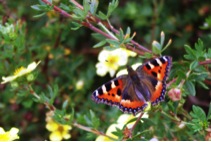Children love to watch caterpillars turn into butterflies, and scientists are no less fascinated by this process. I have mentioned biologist John Bryant’s contribution to the science and faith discussion on this blog a number of times. In this guest post, he writes about his sense of wonder at the processes he studies.
I have been fascinated by the natural world for as long as I can remember, and that fascination led to a career in biology. As a professional biologist my main focus has been the way DNA works as genes, and especially the processes by which DNA is replicated prior to cell division.
Regular readers of this blog will know of the excitement, awe and wonder I have experienced in helping to reach an understanding of the beautifully complex and yet highly controlled mechanisms which work to copy the genome. However, for the moment I want to leave the cell and return to the wider world.
In the UK we recently had The Big Butterfly Count, where members of the general public were encouraged to identify and count the butterflies and moths seen in a particular habitat and submit their results online. The purpose of the count was to assess the status of particular species of butterfly and moth, but it also took me back to the interests and passions of a boy growing up on the edge of the London’s greenbelt, with suburbia in one direction and countryside in the other.
That countryside provided a wealth of interesting things: rich pond life, meadows of wild flowers, nesting birds and a range of caterpillars – the larvae of butterflies and moths.[1] The caterpillars were as varied in appearance as the adults they would turn into – from the rugby-jersey stripes of the cinnabar moth (Tyria jacobaeae)[2] caterpillars to the lean, flexible and slightly spikey caterpillars of the small tortoiseshell butterfly (Aglais urticae) and many more besides.
Alongside this amazing variety of colour and form was the almost incredible fact that a caterpillar turned, via a chrysalis (pupa), into a butterfly or a moth – a process I now know as metamorphosis. I once watched a puss moth (Cerura vinula) emerging from its cocoon (pupa) and then patiently waited while its wings filled and dried. It was so different from the colourful, fierce-looking, fork-tailed caterpillars with which I was also familiar. To a boy of primary (elementary) school age, it seemed like magic.
My friends and I were used to the idea of tadpoles turning into frogs – we had seen this happening to the ones we brought home from the local pond. That seemed to be an ordered and logical process and did not involve a complete change of body plan – just losing some bits and gaining others. But a caterpillar turning into a moth or butterfly almost had the feeling of a frog turning into a prince.
Of course I can now describe the process of metamorphosis in cellular and genetic terms. The caterpillar is an ‘eating machine’ (as the cabbages in my garden testify) with a very fast growth rate. Pupation involves the activation of imaginal disks, which are effectively groups of stem cells from which the adult body is built. The rest of the caterpillar body is digested to provide the raw materials. To enable this process, its DNA is epigenetically re-programmed, enabling the same set of genes to direct the formation of a different type of body (although both larva and adult conform to the same basic insect body plan).
Does knowledge remove wonder, as Keats implied when he wrote about ‘unweaving the rainbow’?[3] Not in the slightest. However much I understand about metamorphosis, it still induces in me the same sense of questioning and wonder that I experienced as a schoolboy. It still seems like magic! So many processes that we biologists almost take for granted are awesomely beautiful in their complexity and order. And that leads me, a biologist-Christian, into an attitude of worship to the creator God.
John Bryant is Professor Emeritus of Biosciences at Exeter, Past-President of the Society for Experimental Biology, a former Chair of Christians in Science, a devoted fan of Crystal Palace FC and an active member of Exeter Network Church.
[1] My account would be incomplete without mentioning other schoolboy activities: there were also streams to be dammed, trees to be climbed and open spaces in which to play football (soccer) and cricket! [2] At that age I knew nothing about Latin names. [3] In Part II of his long poem Lamia written in 1820




